Papers by abolfazl jafari sales
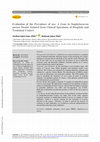
Pajouhan Scientific Journal
Background and Objective: Staphylococcus aureus bacteria is a common cause of hospital infections... more Background and Objective: Staphylococcus aureus bacteria is a common cause of hospital infections. Resistant strains of this bacterium are a major pathogen in causing disease and death in Iran and the world. Therefore, the aim of this study was to investigate the prevalence of mecA methicillin resistance gene and determine antibiotic resistance patterns in S. aureus strains isolated from clinical specimens. Materials and Methods: In this descriptive cross-sectional study, 100 strains of S.aureus from Tabriz hospitals and treatment centers were collected. The isolates were identified by standard laboratory methods and cultured in a specific Culture Media. The identification of MRSA strains was done by phenotypic and molecular methods. The PCR method was used to determine the frequency of mecA gene. In order to evaluate antibiotic susceptibility patterns of strains, a disk diffusion method based on CLSI protocol was performed. Results: Of the 100 samples examined, 75 samples of methicillin-resistant S.aureus were found. The phenotypic evaluation of the antibiotic resistance pattern of methicillin-resistant S.aureus showed that the highest resistance to penicillin antibiotics was 100% and Co-Amoxiclav was 91.66%. Molecular examination revealed the presence of 68% of the mecA gene in isolates. Conclusion: In this study the prevalence of the antibiotic resistance pattern of methicillin-resistant S.aureu was high. This recent study suggests increased resistance to methicillin-resistant S.aureus in compare to other antibiotics, which is a serious warning for the treatment of S.aureus infection in the region. Therefore, in order to prevent the increase of resistance to other antibiotics, it is essential to avoid the administration of uncontrolled and unnecessary antibiotics.
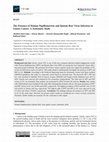
Oncologie
Background and Aim: Gastric cancer (GC) is one of the most common infection-related malignancies ... more Background and Aim: Gastric cancer (GC) is one of the most common infection-related malignancies worldwide. Human Papillomavirus (HPV) and Epstein-Barr virus (EBV) are among the most important viruses affecting many people worldwide. The potential role of these viruses in gastric tissue may explain the possibility of GC, as seen in Helicobacter pylori (H. pylori). This study aimed to systematically investigate the presence of HPV and EBV in GC. Methods: According to the Preferred Reporting Items for Systematic reviews and Meta-Analyses (PRISMA) guidelines, this study is a systematic review based on reported cases. The keywords HPV, EBV and GC, were searched in PubMed, Web of Science, Scopus, EMBASE and Google scholar databases from 2012 to 2022. Articles were selected and evaluated by five researchers independently. The odds ratio of HPV and EBV viruses in GC was estimated. Data analysis was performed by SPSS (Version 20) software. Results: Sixty studies with 14949 patients were included in the study after obtaining the inclusion criteria. The mean prevalence of HPV and EBV viruses in GC was 10.58% and 8.58%, respectively. The highest prevalence of HPV and EBV were 37.74% and 44.44% in Turkey and Iraq, respectively. The highest odds of HPV and EBV in GC were observed in Asia (17.54%) and Africa (19.02%), respectively. Conclusion: The findings indicate the presence of HPV and EBV in GC in the study areas. However, the present study's results are insufficient for a more accurate conclusion. Therefore, further studies are necessary for the conclusion in this regard.
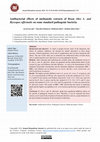
Jorjani Biomedicine Journal
Background and objectives: As much as people become aware of the dangerous side effects of synthe... more Background and objectives: As much as people become aware of the dangerous side effects of synthetic antibiotics, the demand for natural alternatives to these drugs increases. Natural ingredients, lower risk of complications and even have beneficial side effects. The aim of this study was to determine the antibacterial effect of herbs Reum ribes L and hyssop Hyssopus officinalis is on some pathogenic bacteria. Methods: After collecting and confirming the scientific name, the methanolic extract of R. ribes L. and H. officinalis plants was prepared and the antimicrobial effects of the extracts by agar well diffusion and disk diffusion , as well as the determination of The minimum bactericidal concentration and the minimum inhibitory concentration (MIC / MBC) were dilution test on Staphylococcus aureus, Bacillus cereus, Escherichia coli and Pseudomonas aeruginosa .

Jorjani Biomedicine Journal
Background and objectives: Microbial resistance to antibiotics is one of the most common problems... more Background and objectives: Microbial resistance to antibiotics is one of the most common problems in the health care system. Therefore, many efforts have been performed to find new compounds as antimicrobial compounds. This study carried out to investigate the in-vitro antibacterial effect of methanolic extract of peppermint on standard Staphylococcus aureus, Bacillus cereus, Escherichia coli and Pseudomonas aeruginosa strains. Methods: In this experimental laboratory study, after collecting and performing pharmacognosy evaluations, methanolic extract of the peppermint plant was prepared and its antimicrobial effects on several bacteria were determined at concentrations of 20 to 400 mg/ml using the agar well diffusion method, minimum inhibitory concentration (MIC), minimum bactericidal concentration (MBC) methods. The test was repeated five times for each bacterium and the collected data were analyzed using SPSS software. Results: The methanolic extract of peppermint had antimicrobial effects against standard strains of Staphylococcus aureus, Bacillus cereus, Escherichia coli and Pseudomonas aeruginosa. The highest effect was observed in S. aureus and the least in P. aeruginosa. MIC and MBC of methanol extract on S. aureus, B. cereus, E. coli, and P. aeruginosa were 6.5-15.5, 15.5-25, 50-100, and 100-200 mg/ml, respectively. Conclusion: The results of this study showed that peppermint extract can be considered as an antibacterial medicinal herb and that if the concentration of the extract increases, its antibacterial properties will also increase. Thus, it can be used as an alternative to the usual chemical drugs in the treatment of infections after evaluating their effects in vitro.

Antibiotic resistance has paved the way for replacing conventional medications with herbal therap... more Antibiotic resistance has paved the way for replacing conventional medications with herbal therapies that supposedly have less side- effects. This study is done to evaluate the antimicrobial effects of ethanolic extract of Achillea wilhelmsii L. plant on clinical resistant Staphylococcus aureus.After collecting plants and validate its scientific name by botanists of Agricultural Organization and after drying in the shade, extract of Achillea wilhelmsii plant, was extracted by the vacuum distillation method and different concentrations of the extracts were prepared. Then , Minimum inhibitory concentration and minimum bactericidal concentration were determined by broth dilution and agar well diffusion. The results showed that the minimum inhibitory concentration and minimum bactericidal concentration of ethanolic extract was in ranges 6.5 and 13 mgml-1.The results of this study show that can be taken yarrow (Achillea wilhelmsii) in herbal medicines groups with antibacterial properties and after evaluating their effects in vivo condition and to identify the active ingredients, as an alternative to synthetic drugs that commonly used to treat infections.

Objective: Aeromonas hydrophila is a Gram negative, positive oxidase, anaerobic, and opportunisti... more Objective: Aeromonas hydrophila is a Gram negative, positive oxidase, anaerobic, and opportunistic bacteria that, under certain conditions, become a pathogen (in humans and fish). This bacterium causes toxin and host infection in which different antibiotic resistance in isolated strains has been reported in different regions of the world. The aim of this study was to determine the prevalence of this bacterium and its susceptibility to common antibiotics in Tabriz city. Materials and Methods: 50 samples from 5 Reared Oncorhynchus mykiss farms in Tabriz city (For each farm, 10 numbers) were randomly assigned to suspected fish to the disease. Results: By using biochemical tests, 14 samples (28%) from 2 Fish farms (40%) were identified as A. hydrophila. Antibiogram for these specimens showed that the bacterium had the highest resistance to vancomycin (100 %) and clindamycin (92.8%) antibiotics, and has the most sensitivity to the antibiotics of sultrim, tetracycline and oxytetracycline with 71.4%. Discussion: Considering the different antibiotic resistance pattern in this study and other similar studies, the necessity of examining the pattern of resistance in each region seems necessary.

Journal of Clinical Research in Paramedical Sciences, 2021
Background: Nowadays, the resistance of pathogenic bacteria to antibiotics has become a global pr... more Background: Nowadays, the resistance of pathogenic bacteria to antibiotics has become a global problem. Acinetobacter baumannii is an important opportunistic nosocomial pathogen. Acinetobacter baumannii plays a significant role in antibiotic resistance. Objectives: The purpose of this study was to investigate the prevalence of the blaOXA-51, blaNDM, blaVIM, blaPER, blaVEB, blaCTX-M, tetA and tetB genes and antibiotic resistance pattern of A. baumannii isolated from hospitals in Tabriz city, Iran. Methods: This study was descriptive cross-sectional research, performed on 129 isolates of Acinetobacter from different clinical specimens. The Isolates were identified using standard laboratory methods and culture in selective mediums. The antibiotic resistance pattern of isolates was also determined by the Kirby-Bauer disk diffusion susceptibility test. Phenotypic and genotypic detection of blaOXA-51, blaNDM, blaVIM, blaPER, blaVEB, blaCTX-M, tetA and tetB genes in the isolates was carrie...
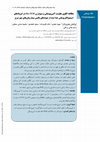
Journal of the Medical Sciences, 2019
Background and Aim: Acinetobacter species are potentially problematic pathogens in multiple hospi... more Background and Aim: Acinetobacter species are potentially problematic pathogens in multiple hospital infections. This bacterium often resists several classes of antibiotics such as beta-lactams, which is an emerging problem in Iran. Therefore, the aim of this study was to determine the pattern of resistance and prevalence of bla-TEM gene in Acinetobacter isolated from Tabriz hospitals. Material and Method: This descriptive cross-sectional study was performed on 148 isolates of Acinetobacter isolated from different clinical specimens. Samples were isolated and identified using standard microbiology laboratory methods and culture on specific environments. Antibiotic resistance patterns of the isolated were defined by Kirby-Bauer disc diffusion method. In order to identify the bla-TEM gene, the combination method was used as a phenotypic method. Additionally, PCR method was used to identify the genotypes. Results: Of 115 isolates (77.7%) of Acinetobacter baumannii, the highest sensitiv...

Electronic Journal of Biology, 2017
The population growth in the present era and the great advances made in life has made the human b... more The population growth in the present era and the great advances made in life has made the human beings inclined towards various industries and materials as a result of which the production and the accumulation of the waste materials in the environment are inevitable. Plastic industries are among the most important and most frequently applied industries and they are widely used and also the increase in the effects brought about by the non-degradable plastic waste has been turned to a growing concern. Polyhydroxyalkanoate (PHA) and Polyhydroxybutyrate (PHB), naturally produced by a great number of the microorganisms, can be considered as a substitute for the ordinary plastics and, unlike the plastics derived from petroleum, PHAs are completely biodegraded in one year by the microorganisms and turn to water and carbon dioxide and return to the nature. PHA and PHB are polyesters produced under imbalanced growth conditions in microorganisms. These polyesters are comprised of hydroxy fatt...

Introduction : Chronic obstructive pulmonary disease (COPD) is the most common cause of death and... more Introduction : Chronic obstructive pulmonary disease (COPD) is the most common cause of death and disability due to pulmonary disease, in Which microbial agents has a significant role. Regarding the role of Chlamydia pneumonia infection in the initiation and development of COPD, this study aimed to evaluate the serum antibody level against C.pneumonia infection in patients with COPD in Tabriz hospitals in 2017. Methods: In this descriptive cross-sectional study, 200 patients with COPD participated. Anti C.pneumoniae titers were determined by ELISA method. Statistical analysis was performed using SPSS software and T-test. Results: The mean IgG antibody was 73.94% and the mean IgM antibody was 0.955%. There was no association between sex with antibody level, smoker status, coronary artery stenosis, and anti-infectious antibodies to C.pneumoniae. Conclusion: According to the results, although there was no significant correlation between C.pneumonia infection and COPD, However, due to...
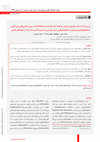
Journal of Fasa University of Medical Sciences, 2016
Background & Objectives : Nowadays, development of drug resistance against chemical antimicrobial... more Background & Objectives : Nowadays, development of drug resistance against chemical antimicrobial drugs has attracted attention using medicinal plants in treatment of infections. The aim of this study is to evaluate the antimicrobial effects of two species of Centaurea plant’s essential oil on drug resistant clinical isolates of three pathogenic isolates. Materials & Methods : The studied plants were collected from Marand city in East Azerbaijan, Iran and were confirmed as Centaurea Depressa M.B. and Centaurea Cyanus L. by botanists of Iran Agriculture Organization. The essential oil of these plants (Stems and leaf) were extracted via steam distillation method by Clevenger, and their antimicrobial effects were studied by well diffusion method in the abovementioned bacteria. The components of essential oil were identified by injection to gas chromatography linked to mass spectrometry (GC/M). Results : The results of this study prove that the essential oils from the abovementioned pla...

Electronic Journal of Biology, 2017
Background: Pseudomonas aeruginosa is the most common pathogen causing nosocomial infections. One... more Background: Pseudomonas aeruginosa is the most common pathogen causing nosocomial infections. One of the reasons for the drug resistance in the Pseudomonas aeroginosa strains is the production of Extended-Spectrum Beta-lactamases enzymes. This study aimed to determine the antibiotic resistance and the frequency of the Extended-Spectrum Betalactamases enzymes (CTX-M1, CTX-M2, CTX-M3) in the Pseudomonas aeroginosa strains isolated in the hospitals of Tabriz Town. Methods: The Pseudomonas aeroginosa strains were collected from different samples of patients admitted to hospitals and medical centers in Tabriz Town during the period from 26th December, 2014 to 25th December 2015. After identifying the phenotypic and genotypic identity (16Sr RNA) and performing antibiogram test, the phenotype of ESBLs in the bacterium of Pseudomonas aeruginosa was evaluated by double-disk synergy method. Then the bacterial DNA was extracted, studied and evaluated by PCR method and using special primers for...
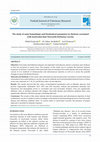
Results : The results showed that the values of biochemical parameters such as albumin, glucose, ... more Results : The results showed that the values of biochemical parameters such as albumin, glucose, total protein, triglyceride, cholesterol, ALT, AST, and ALP enzymes, sodium and potassium minerals, and hematocrit and hemoglobin levels in vaccinated and non-vaccinated chickens were not significantly different. Also, in chickens injected with antigen, Newcastle disease and influenza antibody titers were significantly different with those groups containing adjuvant. Materials and Methods : In this study, after subcutaneous and intramuscular inoculation of inactivated dual oil emulsion Newcastle-Influenza vaccine, the serum antibody level and hematobiochemical factors of these avian were analyzed on 7, 14, 21, and 28 days after vaccine injection. Objective: Newcastle and Influenza diseases are important viral diseases and its occurrence and virulence in Iran has increased in recent years. The purpose of this study was to evaluate the humoral immune responses of chickens vaccinated with i...
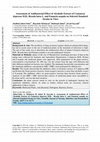
Background & Aim: The incidence of drug resistance against chemical antimicrobial drugs, has led ... more Background & Aim: The incidence of drug resistance against chemical antimicrobial drugs, has led in recent years to the use of medicinal plants in the treatment of infections is high. The aim of this study was to determine the antibacterial effect of plants Centaurea depressa M.B., Reseda lutea and Fumaria asepala is on some pathogenic bacteria. Materials & Methods: plants of the city of Marand East Azerbaijan province of Iran in the spring were collected by botanists and Agriculture Organization, C.depressa M.B., R.lutea and F.asepala and medicinal plants were approved. After preparation of the plant extracts, concentration concentrations 50400 mg / ml, the extract from the agar well diffusion and disk diffusion method on bacteria were studied. The minimum bactericidal concentration and the minimum inhibitory concentration (MIC / MBC) were performed by dilution test. Results: The results showed that the inhibitory effect of alcoholic extracts of C.depressa MB and R.lutea the Gram-p...
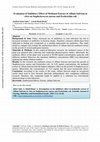
Background & Aim: Today, increased use of antibiotics to treat infections has led to increased re... more Background & Aim: Today, increased use of antibiotics to treat infections has led to increased resistance to antibiotics in bacteria strains. Therefore, extensive efforts have been dedicated to finding new compounds as a suitable replacement for antibiotics. This study aimed to compare and evaluate the antibacterial effects of Allium Sativum methanol extract on the growth of several pathogenic bacteria. Materials & Methods: In this empirical-laboratory research, the methanol extract of the plant was prepared after collecting and conducting pharmacognosy studies. Afterwards, the antibiotic effects of the plant were assessed at 20-400 mg/ml concentrations using the well diffusion method. Moreover, the minimum inhibitory concentration (MIC) was determined applying the tubular dilution method. Results: In this research, the methanol extract of Allium Sativum prevented the growth of Staphylococcus aureus and Escherichia coli. At 6.25 mg/ml concentration, the methanol extract of Allium Sa...

Background: Urinary tract infections are the second most common type of body infection. E. coli i... more Background: Urinary tract infections are the second most common type of body infection. E. coli is the most common cause of urinary tract of infection both sex. This study was done with aim of surveying amount of susceptibility and resistance among strain of E. coli that had been isolated from those who refer to the private laboratories in Tabriz city. Materials and methods: In this cross-sectional study, 2850 E. coli collected from urinary tract infections of the patients. These strains were selected using laboratory standard methods and culture-specific. The antibiotic susceptibility testing was performed using Kirby-Bauer disk diffusion method. Results: The most of sensibility to imipenem were 90%, Nitrofurantoin 87.05%, Amoxicillin 85.27% the most amount for resistant to Ampicillin were 82.95%, Tetracycline 80.1%, Tobramycin 74.25%. Conclusion: This study showed increased resistance to different antibiotics in E. coli that is a serious warning to the treatment of infections caus...
BMC Research Notes, 2021
Objective Helicobacter pylori is one of the most common causes of gastric infections in humans. I... more Objective Helicobacter pylori is one of the most common causes of gastric infections in humans. It is estimated that approximately 50% of people around the world are infected with this bacterium. This study aimed to determine the antibiotic resistance pattern, as well as the frequency of cagA and vacA genes in H. pylori isolates obtained from patients in the clinical centers in Tabriz city, Iran. Results The culture method detected 100 (45.25%) H. pylori isolates from 221 biopsy samples during 3 years. The results showed that 63% and 81% of the isolates were positive for cagA and vacA genes, respectively. The highest resistance of isolates was seen against metronidazole (79%) and amoxicillin (36%), respectively. Also, the isolates showed the least resistance to tetracycline (8%).
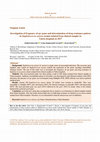
Medical Journal of Tabriz University of Medical Sciences and Health Services, 2020
Background: Staphylococcus aureus (S. aureus) is major cause of nosocomial infections. The access... more Background: Staphylococcus aureus (S. aureus) is major cause of nosocomial infections. The accessory gene regulator (agr) system of Staphylococcus aureus controls the expression of the genes encoding extracellular virulence factors. The aim of this study was to investigate the frequency of agr genes and drug resistance in Staphylococcus aureus strains isolated from clinical samples in Tabriz hospitals. Methods: This cross-sectional study was done among a total of 100 strains isolated from clinical samples in Tabriz hospitals. Antibiotic susceptibility pattern of all isolates was determined by disk diffusion method. After DNA extraction, the presence of agr genes was investigated using Multiplex PCR. SPSS software was used to perform statistical tests. Results: Among 100 Staphylococcus aureus strains, 38 isolates were resistant to methicillin. They were susceptible to rifampin (89%) and vancomycin (86%) but showed resistance to penicillin (98%) and tetracycline (85%). The most prevalent gene was agrA (65%) followed by the agrC (29%) in strains. None of the isolates harbored the agrB and agrD genes. Conclusion: agrA and agrC genes play an important role in staphylococcal infections in clinical samples isolated from Tabriz hospitals. Also, the results showed high rates of multi-drug resistance in Staphylococcus aureus strains isolated from Tabriz hospitals. Therefore, it is recommended to limit the unnecessary uses of antibiotics.
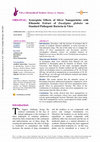
Tabari Biomedical Student Research Journal, 2020
Introduction: Nowadays, with the increase of resistance due to overuse of synthetic chemical anti... more Introduction: Nowadays, with the increase of resistance due to overuse of synthetic chemical antibiotics, it seems necessary to find alternative drugs. The aim of this study was to compare the effects of silver nanoparticles and Eucalyptus globules (eucalyptus) ethanolic extract on standard bacteria of Staphylococcus aureus, Bacillus cereus, Pseudomonas aeruginosa and Escherichia coli. Material and Methods: In this experimental study, aerial parts of Eucalyptus plant were collected from Marand city and identified as Eucalyptus plant by botanists of Islamic Azad University, Ahar Branch. In this study, eucalyptus ethanolic extract was prepared by Soxhlet method and the antibacterial effects of eucalyptus extract at concentrations of 20, 30, 50 and 400 mg / ml and silver nanoparticles at concentrations of 10, 20, 40 and 80 μg / ml with agar well diffusion methods and tubular dilution were investigated. Results: The results showed that the ethanolic extract of Eucalyptus had more antiba...
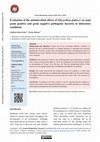
Jorjani Biomedicine Journal, 2018
Background and objectives: Today, due to the increasing antibiotic resistance of bacteria, the us... more Background and objectives: Today, due to the increasing antibiotic resistance of bacteria, the use of medicinal plants as a suitable alternative to antibiotics has increased significantly; therefore, in this study, the antibacterial effects of methanolic extracts of Staphylococcus aureus, Bacillus cereus, Pseudomonas aeruginosa and Escherichia coli were evaluated. Methods: In this laboratory research, after collecting plants and confirming its scientific name, extract of Glycyrrhiza glabra L. Root was prepared by Soxhlet extractor method at concentrations of 20 mg / ml to 400 mg / ml. Then the antimicrobial effects of this extract were investigated using Agar well diffusion and Dilution test methods. Results: The results showed that the methanolic extracts of G.glabra L. in both Agar well diffusion and Dilution test methods had antibacterial effects on the tested bacteria. The highest effect was observed on S.aureus and the lowest effect was observed in P.aeruginosa. Conclusion: According to the above results, it can be expected that the G.glabra L. extract can be used to treat bacterial infections and is a suitable alternative to commonly used chemical treatments for the treatment of infections.









Uploads
Papers by abolfazl jafari sales